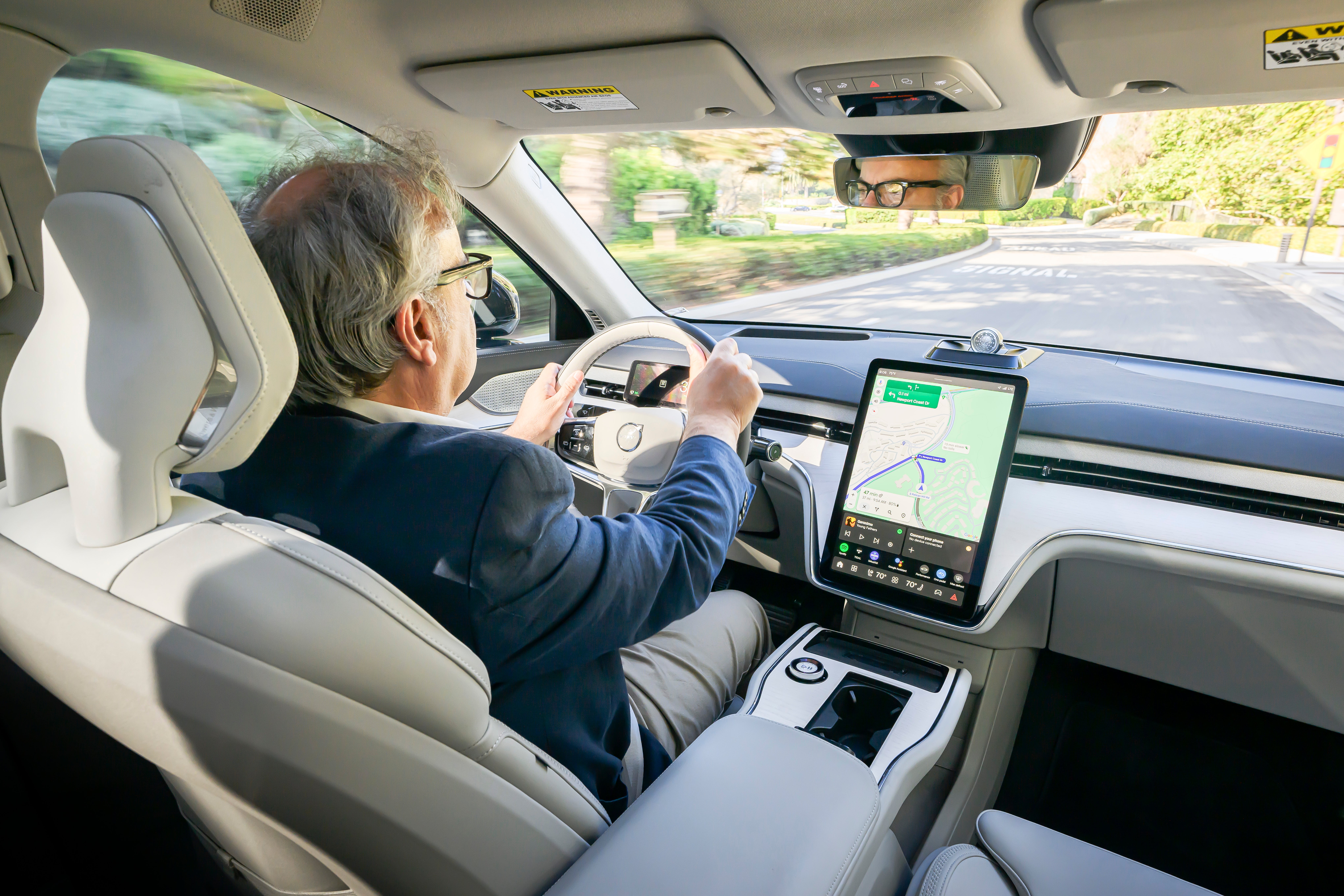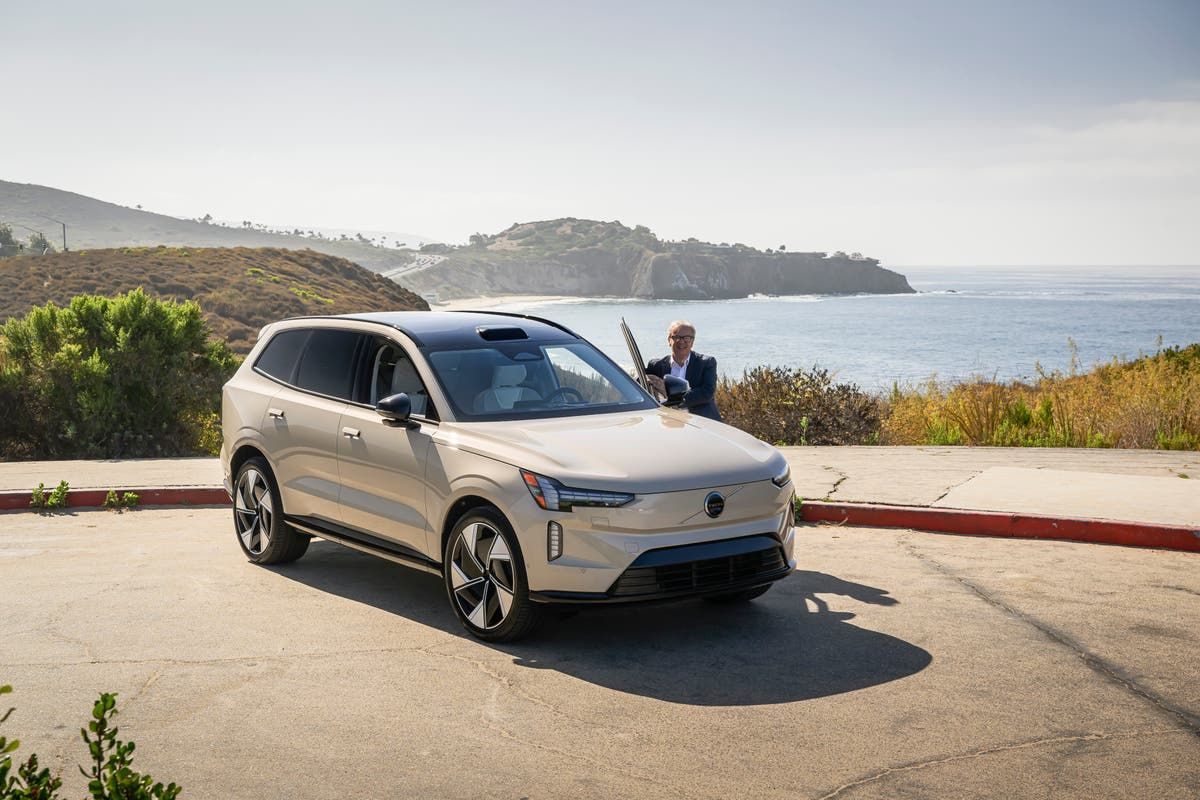Your support helps us tell the story.
In my reporting on women's reproductive rights, I have witnessed the critical role that independent journalism plays in protecting freedoms and informing the public.
Your support allows us to keep these vital issues under the spotlight. Without your help, we would not be able to fight for truth and justice.
Every contribution ensures that we can continue reporting on the stories that impact lives.
Kelly Rissman
US News Reporter
QThe most intriguing thing about the new all-electric Volvo EX90 is a strange dark glass that sits between the windscreen and the roof. It's so well integrated into the look of the car that it's hard not to notice it.
It looks like a “taxi” sign on a London cab when it’s off, but it’s actually a “lidar.” According to my online sources, it stands for “light detection and measuring,” and it projects laser beams from the front of the vehicle to build a three-dimensional image of what the car “sees.”
This isn't currently operational as an aid to help you, or rather the Volvo, see in the dark and avoid collisions with stray foxes and the like, but is there to collect, record and transmit to Volvo's technology partners thousands, indeed millions, of reference points so that the technology can become truly useful.

For the peace of mind of conspiracy theorists (assuming they can be appeased), “spying” on your activities is only allowed with your own permission, and for the peace of mind of the rest of us, this research will help us all avoid accidents in the long run. Plus, the “disused taxi sign” is a nice conversation piece, you see.
I should add that the lidar is also complemented by real-time driver assistance, with eight cameras, five radars and 12 ultrasonic sensors. All of this helps you stay alert.

Another notable feature of the EX90 is that it is the most expensive production Volvo, coming in just under the £100,000 mark. I should probably think about that for a moment before trying to justify it, which I don't think I can quite do.
The value-for-money argument is that it's a very good car for the money. And that's true, considering it weighs a whopping 2.7 tonnes. Much of this is down to the gigantic battery (111kWh, an impressive figure even for this class) and the dual-motor setup, one for each axle, which provides a huge amount of well-controlled torque.
There are only seven seats in the launch editions, all of them adult-sized. The interior is as luxurious as you'd expect, and Volvo's usual excellent sense of good taste is evident throughout.

Of course, these days this is tempered by environmental concerns, so the wool seats are partly made from recycled materials, and what passes for soft leather is actually something called “Nordico” (no joke), which Volvo tells me is made up of recycled polyethylene terephthalate (PET) bottles – bio-sourced PVC resin from Swedish and Finnish forests. So there’s that. Another talking point, and I can confirm that it’s very comfortable – and the electric seats are heated (of course) with an adjustable cushion, so you can make sure the backs of your knees enjoy proper support.
Volvo is also rightly proud of the Bowers and Wilkins sound system. I have very thin ears, but even I can appreciate the way they have managed to create different optional boardroom and studio sound effects in the cabin. Audiophiles will love it. In time, “cheaper”, less powerful and less sophisticated versions of the XC90 will arrive.
I wouldn't say the EX90, with all its exquisite detailing and comfortable ride, is on a par with a Range Rover, but it provides a credible challenge and is far greener (the world still awaits the all-electric Rangie and its Jaguar siblings).

But the EX90 is more refined than the older gas-powered or hybrid XC90 (which will soon be extensively updated and will remain in production for its many fans).
Overall, whether you choose a Kia EV9, a BMW iX, an Audi Q8 e-tron, a Genesis GV80, or a Mercedes Benz EQE SUV for your giant bridge-busting battery-powered vehicle is largely a matter of taste. They're all good, if a little heavy. Of course, if you're not a fan of taste, you can opt for one of Trump-loving Musk's models. We'll say no more on that.
The EX90 handles remarkably well, considering its size, and miniature networked supercomputers ensure acceleration and cornering are handled as expected.

The styling is very old-school Volvo, which will delight those the company needs to transition from its XC60 and XC90, but a disappointment to those hoping for a stretched version of the popular EX40.
All of this leaves me with one problem: the touchscreen. Everything works just fine, this portrait-format tablet with Google, apps and excellent connectivity. The problem, of course, is that you have to do too much via the touchscreen, even with voice control, handy steering wheel buttons and a rotary dial for audio located on the centre console.
To adjust the wing mirrors or steering wheel you no longer have a lever or button at hand, but need to navigate through menus. And if you want to flag down a hazard on the motorway, you have to try tapping the little red triangle icon in the corner of the screen, rather than a more obvious button on the dashboard.
THE SPECIFICATION
Volvo EX90 Performance
Price:£100,555 (based on tests, the range will start at £75,000)
Propulsion:Double electric motor, powered by a 111 kWh battery
Power (HP):510
Maximum speed (mph):112
0-60 (seconds):4.9
Economy (Wh/mile):382
Range (miles): about 280
CO2 emissions: 0
Of course, regular owners will be used to this to a certain extent, but it's neither intuitive nor particularly safe. The latest new cars have ditched the touchscreen mania and reverted to more physical controls.
The new EX90, which has been in development for a long time, seems more like it was conceived in an earlier era, when everyone was fascinated by the gigantic, minimalist touchscreens in Teslas.
Much like the styling (modern and advanced, of course), the Volvo's extreme touchscreen doesn't seem to be keeping up with current trends in these areas. It seems to have arrived a little late to the market, as they say in the industry.

Ironically, given all that effort, Volvo has now said its goal of being a 100 percent battery electric vehicle (BEV) maker by 2030 is being revised to be 90 percent “plug-in,” which includes plug-in hybrids with gasoline engines, and about 10 percent “mild hybrids,” which are basically gasoline and diesel.
The company seems to be listening to its customers and being pragmatic. I don't think it has much choice, even if it is owned by Geely, one of the Chinese giants.
Still, as we cruised along the California coastal highway during our test drive, the Volvo had an air of understated luxury and instilled in its owner a sense of well-being that bordered on smugness. Very, very Volvo.












